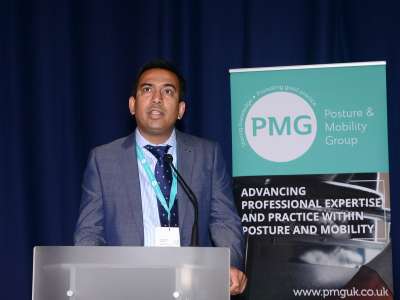
As an independent occupational therapist (OT) I am increasingly working with clients with spinal cord injuries. Although I have 10 years’ experience as a qualified OT, and a good understanding of static seating, I have little experience of wheelchairs, clearly an area of great importance to this client base. Being awarded a bursary to attend the PMG Conference 2019 was therefore extremely welcome, as conferences are expensive but always an excellent learning and networking opportunity.
The exhibition at the event was superb, displaying a wealth of assistive technology to inspect and try out, with someone always on hand to explain the equipment and answer any questions. As I have a real interest in assistive technology, I enjoy the opportunity to learn about new and innovative products, and I was not disappointed.
Of all the plenary sessions, I was particularly interested in the presentation by Mr Naveen Kumar, consultant in spinal cord injury at the Midland Centre for Spinal Injuries - "Current concepts and technological advances to improve mobility for spinal cord injury" - as I felt it would increase my understanding of how treatment of this condition has progressed over the years.
Mr Kumar (pictured) began by referring us to Sir Ludwig Guttman, the German neurosurgeon who fled to the UK during the second world war and, in 1943, was invited by the British government to open a spinal injuries centre at Stoke Mandeville hospital where he organised the first Stoke Mandeville games for disabled people in 1948 (Paralympic Movement, 2018). He was not a sportsman himself, but understood the importance of sport for giving his patients an interest, and helping with their acceptance back into society.
The Stoke Mandeville games were the precursor of today’s Paralympics, and the WheelPower Inter Spinal Unit Games (Stewarts, 2019) are still held there to this day. It was all very interesting, particularly as my first private client took part in the games this year.
Mr Kumar went on to talk about the 12 spinal injuries centres in the UK, discussed the patient population, and showed a most interesting video clip from 1934 of a patient demonstrating excellent mobility following treatment. He then discussed the study 'Active physiological conservative management in traumatic spinal cord injuries: an evidence-based approach' which he co-authored with Dr William El Masri (Masri & Kumar, 2017). The study describes the ultimate goal of active conservative management to be "maximum neurological recovery and independence, a pain-free and flexible spine, safe and convenient functioning of the various systems of the body with minimal inconvenience to patients, and the prevention of complications". He also talked about a table tilt study (Craven et al, 2013) which considered the benefits of using a robotic tilting table to increase cardiopulmonary fitness and energy levels, thereby decreasing the risk of coronary heart disease and cardiovascular complications.
Mr Kumar used a brief case study of a young girl who had sustained very severe spinal injuries to demonstrate that, with good conservative management, reasonable recovery can be made. He went on to discuss a range of treatments available today: stem cell therapy (NHS, 2018), functional electrical stimulation (Ho et al, 2014) - the use of electrical devices to stimulate communication between the brain and the body - plus a range of technical options such as:
- Oswestry standing frame
- Orlau Parawalker
- Ekso suit
- Rewalk
- Rex Bionics
- Indego
He also discussed virtual reality (VR), an artificial environment that is created using computer software. A study by Chi et al (2019) found that the most frequent method used was virtual walking which creates a VR environment that enhances the subject’s ability to imagine themselves walking. Mr Kumar emphasised the importance of using an integration of techniques that include functional electrical stimulation, functional magnetic stimulation, brain computer interface, and artificial intelligence.
Finally, he described another case study, this time of a well-known mountain biker who sustained a spinal cord injury and, following treatment, was able to get back on his bike, even though he had no feeling in his legs.
As a result of this excellent presentation, I have increased my knowledge of the treatments available for spinal cord injuries, and also gained an understanding of what my clients may have experienced prior to their discharge from hospital.
References:
Chi B, Chau B, Yeo P (2019). Virtual reality fir spinal cord injury–associated neuropathic pain: Systematic review Annals of Physical and Rehabilitation Medicine 62:1 p49-57
Craven CTD, Gollee H, Coupaud S, Purcell MA, Allen DB (2013). Investigation of robotic-assisted tilt-table therapy for early stage spinal cord injury rehabilitation. Journal of Rehabilitation Research & Development 50:3 p367-378
El Masri W, Kumar N (2017). Active physiological conservative management in traumatic spinal cord injuries – an evidence based approach. Trauma 19:1 p 10–22
Ho CH, Triolo RJ, Elia AL, Kilgore KL, DiMarco F, Bogie K, Vette AH, Audu ML, Kobetic R, Chang SR, MingChan K, Dukelow S, Bourbeau DJ, Brose SW, Gustafson KJ, Kiss ZHT, Mushahwar VK (2014). Functional Electrical Stimulation and Spinal Cord Injury. Physical Medicine and Rehabilitation Clinics of North America 25:3 P 631-654
NHS (2018) ASCOT Trial Available from: https://www.rjah.nhs.uk/Research/ASCOT-Trial.aspx [Accessed 20th July 2019]
Paralympic Movement (2018). Stoke Mandeville 70: Celebrating Sir Ludwig Guttman. Available from: https://www.paralympic.org/news/stoke-mandeville-70-celebrating-sir-ludwig-guttmann [Accessed 20th July 2019]
Stewarts (2019). Wheelpower Inter Spinal Unit Games 2019. Available from: https://www.stewartslaw.com/news/wheelpower-inter-spinal-unit-games-2019/ [Accessed 20th July 2019]
Members of PMG can view Mr Kumar's presentation online by clicking here.






.jpg)



no comments
Add your comment...